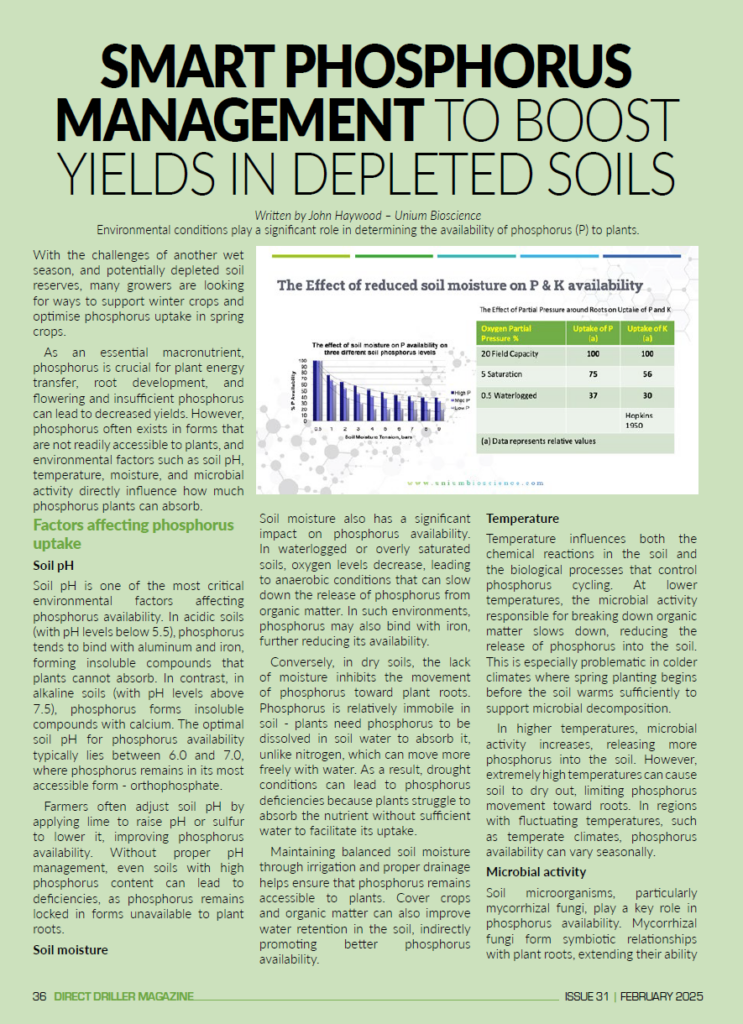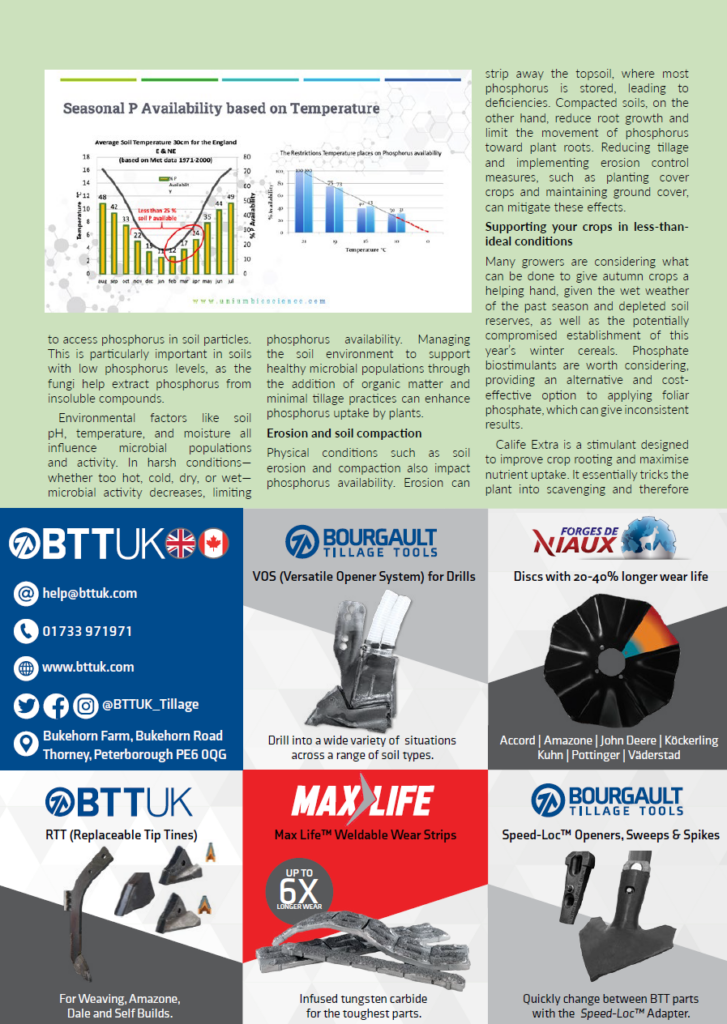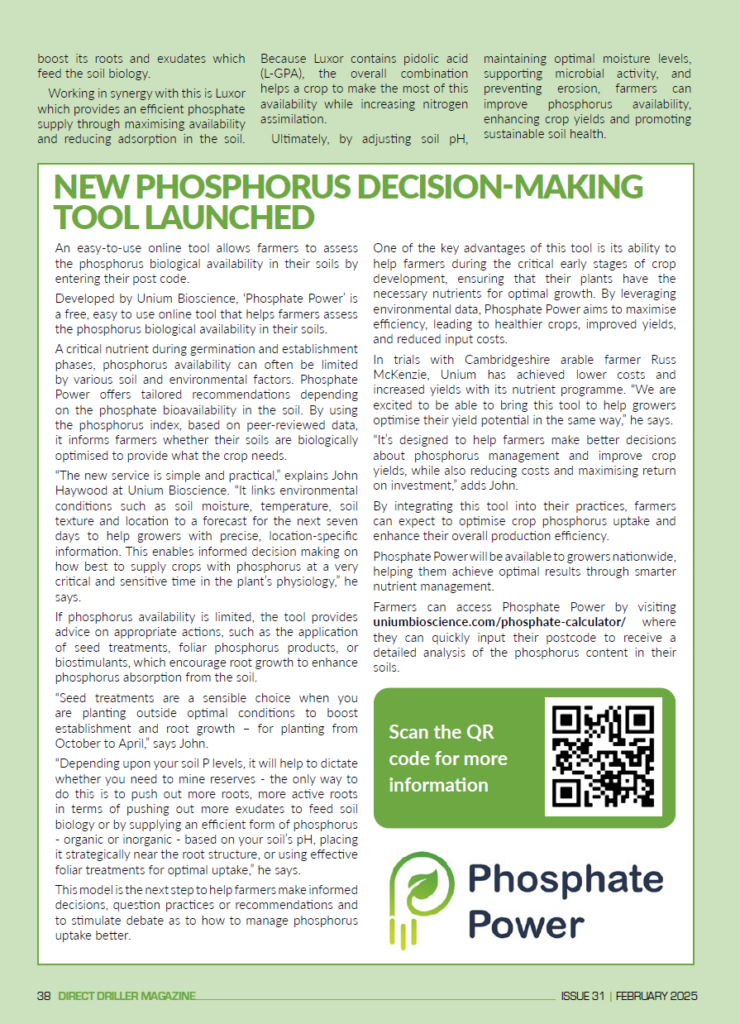WRITTEN BY JOHN HAYWOOD – UNIUM BIOSCIENCE
Standfirst: Environmental conditions play a significant role in determining the availability of phosphorus (P) to plants.
With the challenges of another wet season, and potentially depleted soil reserves, many growers are looking for ways to support winter crops and optimise phosphorus uptake in spring crops.
As an essential macronutrient, phosphorus is crucial for plant energy transfer, root development, and flowering and insufficient phosphorus can lead to decreased yields. However, phosphorus often exists in forms that are not readily accessible to plants, and environmental factors such as soil pH, temperature, moisture, and microbial activity directly influence how much phosphorus plants can absorb.
Factors affecting phosphorus uptake
Soil pH
Soil pH is one of the most critical environmental factors affecting phosphorus availability. In acidic soils (with pH levels below 5.5), phosphorus tends to bind with aluminum and iron, forming insoluble compounds that plants cannot absorb. In contrast, in alkaline soils (with pH levels above 7.5), phosphorus forms insoluble compounds with calcium. The optimal soil pH for phosphorus availability typically lies between 6.0 and 7.0, where phosphorus remains in its most accessible form – orthophosphate.
Farmers often adjust soil pH by applying lime to raise pH or sulfur to lower it, improving phosphorus availability. Without proper pH management, even soils with high phosphorus content can lead to deficiencies, as phosphorus remains locked in forms unavailable to plant roots.
Soil moisture
Soil moisture also has a significant impact on phosphorus availability. In waterlogged or overly saturated soils, oxygen levels decrease, leading to anaerobic conditions that can slow down the release of phosphorus from organic matter. In such environments, phosphorus may also bind with iron, further reducing its availability.
Conversely, in dry soils, the lack of moisture inhibits the movement of phosphorus toward plant roots. Phosphorus is relatively immobile in soil – plants need phosphorus to be dissolved in soil water to absorb it, unlike nitrogen, which can move more freely with water. As a result, drought conditions can lead to phosphorus deficiencies because plants struggle to absorb the nutrient without sufficient water to facilitate its uptake.
Maintaining balanced soil moisture through irrigation and proper drainage helps ensure that phosphorus remains accessible to plants. Cover crops and organic matter can also improve water retention in the soil, indirectly promoting better phosphorus availability.

Temperature
Temperature influences both the chemical reactions in the soil and the biological processes that control phosphorus cycling. At lower temperatures, the microbial activity responsible for breaking down organic matter slows down, reducing the release of phosphorus into the soil. This is especially problematic in colder climates where spring planting begins before the soil warms sufficiently to support microbial decomposition.
In higher temperatures, microbial activity increases, releasing more phosphorus into the soil. However, extremely high temperatures can cause soil to dry out, limiting phosphorus movement toward roots. In regions with fluctuating temperatures, such as temperate climates, phosphorus availability can vary seasonally.

Microbial activity
Soil microorganisms, particularly mycorrhizal fungi, play a key role in phosphorus availability. Mycorrhizal fungi form symbiotic relationships with plant roots, extending their ability to access phosphorus in soil particles. This is particularly important in soils with low phosphorus levels, as the fungi help extract phosphorus from insoluble compounds.
Environmental factors like soil pH, temperature, and moisture all influence microbial populations and activity. In harsh conditions—whether too hot, cold, dry, or wet—microbial activity decreases, limiting phosphorus availability. Managing the soil environment to support healthy microbial populations through the addition of organic matter and minimal tillage practices can enhance phosphorus uptake by plants.
Erosion and soil compaction
Physical conditions such as soil erosion and compaction also impact phosphorus availability. Erosion can strip away the topsoil, where most phosphorus is stored, leading to deficiencies. Compacted soils, on the other hand, reduce root growth and limit the movement of phosphorus toward plant roots. Reducing tillage and implementing erosion control measures, such as planting cover crops and maintaining ground cover, can mitigate these effects.
Supporting your crops in less-than-ideal conditions
Many growers are considering what can be done to give autumn crops a helping hand, given the wet weather of the past season and depleted soil reserves, as well as the potentially compromised establishment of this year’s winter cereals. Phosphate biostimulants are worth considering, providing an alternative and cost-effective option to applying foliar phosphate, which can give inconsistent results.
Calife Extra is a stimulant designed to improve crop rooting and maximise nutrient uptake. It essentially tricks the plant into scavenging and therefore boost its roots and exudates which feed the soil biology.
Working in synergy with this is Luxor which provides an efficient phosphate supply through maximising availability and reducing adsorption in the soil. Because Luxor contains pidolic acid (L-GPA), the overall combination helps a crop to make the most of this availability while increasing nitrogen assimilation.
Ultimately, by adjusting soil pH, maintaining optimal moisture levels, supporting microbial activity, and preventing erosion, farmers can improve phosphorus availability, enhancing crop yields and promoting sustainable soil health.

New phosphorus decision-making tool launched
An easy-to-use online tool allows farmers to assess the phosphorus biological availability in their soils by entering their post code.
Developed by Unium Bioscience, ‘Phosphate Power’ is a free, easy to use online tool that helps farmers assess the phosphorus biological availability in their soils.
A critical nutrient during germination and establishment phases, phosphorus availability can often be limited by various soil and environmental factors. Phosphate Power offers tailored recommendations depending on the phosphate bioavailability in the soil. By using the phosphorus index, based on peer-reviewed data, it informs farmers whether their soils are biologically optimised to provide what the crop needs.
“The new service is simple and practical,” explains John Haywood at Unium Bioscience. “It links environmental conditions such as soil moisture, temperature, soil texture and location to a forecast for the next seven days to help growers with precise, location-specific information. This enables informed decision making on how best to supply crops with phosphorus at a very critical and sensitive time in the plant’s physiology,” he says.
If phosphorus availability is limited, the tool provides advice on appropriate actions, such as the application of seed treatments, foliar phosphorus products, or biostimulants, which encourage root growth to enhance phosphorus absorption from the soil.
“Seed treatments are a sensible choice when you are planting outside optimal conditions to boost establishment and root growth – for planting from October to April,” says John.
“Depending upon your soil P levels, it will help to dictate whether you need to mine reserves – the only way to do this is to push out more roots, more active roots in terms of pushing out more exudates to feed soil biology or by supplying an efficient form of phosphorus – organic or inorganic – based on your soil’s pH, placing it strategically near the root structure, or using effective foliar treatments for optimal uptake,” he says.
This model is the next step to help farmers make informed decisions, question practices or recommendations and to stimulate debate as to how to manage phosphorus uptake better.
One of the key advantages of this tool is its ability to help farmers during the critical early stages of crop development, ensuring that their plants have the necessary nutrients for optimal growth. By leveraging environmental data, Phosphate Power aims to maximise efficiency, leading to healthier crops, improved yields, and reduced input costs.
In trials with Cambridgeshire arable farmer Russ McKenzie, Unium has achieved lower costs and increased yields with its nutrient programme. “We are excited to be able to bring this tool to help growers optimise their yield potential in the same way,” he says.
“It’s designed to help farmers make better decisions about phosphorus management and improve crop yields, while also reducing costs and maximising return on investment,” adds John.
By integrating this tool into their practices, farmers can expect to optimise crop phosphorus uptake and enhance their overall production efficiency.
Phosphate Power will be available to growers nationwide, helping them achieve optimal results through smarter nutrient management.
Farmers can access Phosphate Power by visiting uniumbioscience.com/phosphate-calculator/ where they can quickly input their postcode to receive a detailed analysis of the phosphorus content in their soils.



